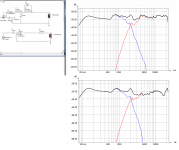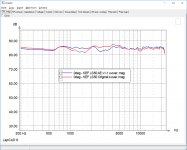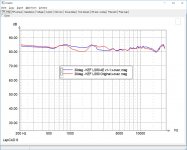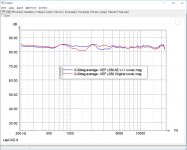I'm posting .txt files that you can convert to .frd or .zma if your simulator needs it. I derived frequency files with about 10ms gate time. I didn't merge it to get low frequency response of woofer (under 120Hz) because i'm not interested in it. In the .zip file that is available for download from my DB account there is another .zip file that can be uploaded to HolmImpulse if you are not satisfied how i extracted sim files so you can do it as you see fit. All measurements are done from about 108cm on axis and approximately 30 degrees off axis. It is not good as 0-180 in 10 degrees increments but if you cross it over between 2000-2800Hz you won't get into trouble. Any fine tuning i recommend to be done by measuring and listening of your drivers.
If there's anything that you want me to do (other than measuring TS for woofers because i'm not doin' it ) feel free to ask.
) feel free to ask.
Dropbox - Kef LS50 measurements and sim files.zip - Simplify your life
Measurements done with calibrated Behringer ECM8000, M-audio FastTrack USB, Holmimpulse.
Measurement conditions
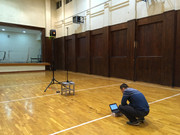
https://i.postimg.cc/B68BsJQX/IMG-2671.jpg
Midwoofer and tweeter

https://i.postimg.cc/gkbHFF92/50-a.png

https://i.postimg.cc/1RqrjRjd/50.png
Simulation of Kef's factory crossover: frequency, impedance and phase response
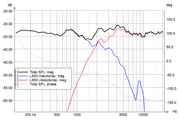
https://i.postimg.cc/yxchgnRK/LS50.png

https://i.postimg.cc/QtRkdvHS/LS50.png

https://i.postimg.cc/QNyvpMWn/50.png
Few comments:
In Kef LS50 they've seem to have done around 8dB baffle step compensation for midwoofer. That sounds like a lot but surprisingly it doesn't sound that bad at all. I guess that it doesn't go much low so it kinda evens out. Tweeter level is set, as can be seen, a 1.5-2dB higher than midwoofer. Again, i'm surprised that it isn't perceived like overly bright. You can hear it being louder but it doesn't make you want to turn the volume down - quite strange actually, unlike any metal dome i've listened so far. Also, good thing i've prepared and measured both cabinets because there are few measured differences between drivers. You'll see.
So, that being said, feel free to share what you've achieved with this or with your LS50's. I know i will.
EDIT: Couple of guys chimed in also so this is our take on KEF LS50 ALTERNATIVE CROSSOVER:
Zvu PSM XO
Göran
XMechanik
Enjoy and have fun.
If there's anything that you want me to do (other than measuring TS for woofers because i'm not doin' it
Dropbox - Kef LS50 measurements and sim files.zip - Simplify your life
Measurements done with calibrated Behringer ECM8000, M-audio FastTrack USB, Holmimpulse.
Measurement conditions

https://i.postimg.cc/B68BsJQX/IMG-2671.jpg
Midwoofer and tweeter

https://i.postimg.cc/gkbHFF92/50-a.png

https://i.postimg.cc/1RqrjRjd/50.png
Simulation of Kef's factory crossover: frequency, impedance and phase response

https://i.postimg.cc/yxchgnRK/LS50.png

https://i.postimg.cc/QtRkdvHS/LS50.png

https://i.postimg.cc/QNyvpMWn/50.png
Few comments:
In Kef LS50 they've seem to have done around 8dB baffle step compensation for midwoofer. That sounds like a lot but surprisingly it doesn't sound that bad at all. I guess that it doesn't go much low so it kinda evens out. Tweeter level is set, as can be seen, a 1.5-2dB higher than midwoofer. Again, i'm surprised that it isn't perceived like overly bright. You can hear it being louder but it doesn't make you want to turn the volume down - quite strange actually, unlike any metal dome i've listened so far. Also, good thing i've prepared and measured both cabinets because there are few measured differences between drivers. You'll see.
So, that being said, feel free to share what you've achieved with this or with your LS50's. I know i will.
EDIT: Couple of guys chimed in also so this is our take on KEF LS50 ALTERNATIVE CROSSOVER:
Zvu PSM XO
Göran
XMechanik
Enjoy and have fun.
Last edited:
Great to see good agreements to measurements to stereophile and soundstage, even though the onaxis response looks so-so the evenness off axis looks great
Hi,
Tomorrow I will post some simulations and an alternative x-over suggestion for the LS50 speaker based on Zvu's measurements.
Cheers,
/G
I've been listening for a few days this crossover:
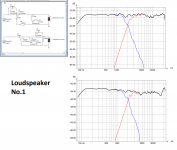
Loudspeaker No.2 has few slight changes in crossover and one significant:
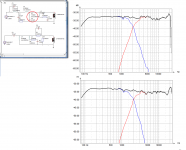
The surround on that midwoofer didn't get enough coating so its resonance is quite visible. I decided to solve it with LC filter. 2x4,7uF in series and 7.5mH/Rdc=12.5ohm. 2.2uF will also work but i ran out of 2.2uF capacitors and i was eager to listen to it. The coil is Jantzen, catalog number 000-1541 and can be bought at HiFiCollective for about 3 euros a piece. Its outer diameter is 26mm and it is 15mm high but without it the response looks like this and that was unacceptable to me:
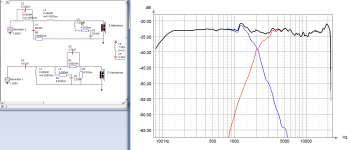

Loudspeaker No.2 has few slight changes in crossover and one significant:

The surround on that midwoofer didn't get enough coating so its resonance is quite visible. I decided to solve it with LC filter. 2x4,7uF in series and 7.5mH/Rdc=12.5ohm. 2.2uF will also work but i ran out of 2.2uF capacitors and i was eager to listen to it. The coil is Jantzen, catalog number 000-1541 and can be bought at HiFiCollective for about 3 euros a piece. Its outer diameter is 26mm and it is 15mm high but without it the response looks like this and that was unacceptable to me:

Last edited:
Hi Zvu,
Do you have the rdc for the coils or the wire gauge for the LS50 original x-over?
Best regards
/Göran
Hi Göran,
I don't have it but when i take the factory crossovers out of the cabinets, which will most likely be when i put the new ones in, i will unsolder it and measure it for reference. I'll publish here, of course.
Great to see good agreements to measurements to stereophile and soundstage, even though the onaxis response looks so-so the evenness off axis looks great
On axis is quite similar to SoundStage measurements also, but the resolution i show is different so it maybe looks a bit more sinister. Also, there are some variation issues between my two midwoofers so i'm quite surprised that my measurements were so similar to what they measured in the first place.
Last edited:
Simulation of the original KEF LS50 x-over
Hi everyone,
Here's my simulation of the original KEF LS50 x-over based on measurements made by Zvu in post 1 in this thread.
I have only briefly listened to this speaker at some Hifi shows and perhaps not in the best environments to do critical listening. However, what I've heard hasn't caught my interest to do any more deep listening sessions with this speaker.
KEF do make some very nice co-axial drivers and I've listened to their top models like the KEF Blade and the KEF Reference 1, which I liked, but they play in a different league than the LS50.
I don't know the design objectives KEF had with this speaker, but it seems that they have done a type of LR2 cross-over topology (acoustical). Unlike many e.g. B&W loudspeaker designs, It's not a minimalistic design approach, since the x-over uses a fair amount of components.
In the original x-over, the tweeter is connected with reverse polarity and as can be seen in the simulations, the tweeter is a bit hot in the 2-6kHz region. This can make the speaker a bit bright and analytic sounding and in the long run a bit fatiguing sounding.
The drivers individual phase response doesn't track each other particular well. This is also confirmed by reversing the polarity of the tweeter as it doesn't have a deep null at the x-over frequency.
Ideally, the individual driver relative phase response should be tracking each other closely, not only at the x-over frequency, but also at least 1-2 octaves below and above the x-over frequency.
If the phase relationship between the the drivers is less good as in this case, the loudspeaker will sound less coherent and with a smaller sound stage and having less good imaging. The drivers will also blend less good and they will not sound like one point of sound source.
In extreme cases you can experience a sound where the tweeter and woofer doesn't blend well and seem to live their own life apart from each other in the sound stage. It can be quite annoying and fatiguing in the long run.
Personally I hate that kind of sound. I don't say that the LS50 is that extreme, but the phase response could be better for optimal sound from this nice driver units.
In the next post I will show an alternative x-over design for the KEF LS50 speaker for anyone to play around with.
Cheers,
/Göran
Picture1: KEF LS50 - On-axis frequency response (original x-over)
Picture2: KEF LS50 - On-axis frequency response reverse tweeter polarity (original x-over)
Picture3: KEF LS50 - On-axis phase response (original x-over)
Picture4: KEF LS50 - On-axis tweeter frequency response (original x-over)
Picture5: KEF LS50 - On-axis woofer frequency response (original x-over)
Picture6: KEF LS50 - 30deg off-axis frequency response (original x-over)
Picture7: KEF LS50 - 30deg off-axis frequency response reverse polarity (original x-over)
Picture8: KEF LS50 - 30deg off-axis phase response (original x-over)
Picture9: KEF LS50 - 0-30deg + 0-30deg average frequency response (original x-over)
Hi everyone,
Here's my simulation of the original KEF LS50 x-over based on measurements made by Zvu in post 1 in this thread.
I have only briefly listened to this speaker at some Hifi shows and perhaps not in the best environments to do critical listening. However, what I've heard hasn't caught my interest to do any more deep listening sessions with this speaker.
KEF do make some very nice co-axial drivers and I've listened to their top models like the KEF Blade and the KEF Reference 1, which I liked, but they play in a different league than the LS50.
I don't know the design objectives KEF had with this speaker, but it seems that they have done a type of LR2 cross-over topology (acoustical). Unlike many e.g. B&W loudspeaker designs, It's not a minimalistic design approach, since the x-over uses a fair amount of components.
In the original x-over, the tweeter is connected with reverse polarity and as can be seen in the simulations, the tweeter is a bit hot in the 2-6kHz region. This can make the speaker a bit bright and analytic sounding and in the long run a bit fatiguing sounding.
The drivers individual phase response doesn't track each other particular well. This is also confirmed by reversing the polarity of the tweeter as it doesn't have a deep null at the x-over frequency.
Ideally, the individual driver relative phase response should be tracking each other closely, not only at the x-over frequency, but also at least 1-2 octaves below and above the x-over frequency.
If the phase relationship between the the drivers is less good as in this case, the loudspeaker will sound less coherent and with a smaller sound stage and having less good imaging. The drivers will also blend less good and they will not sound like one point of sound source.
In extreme cases you can experience a sound where the tweeter and woofer doesn't blend well and seem to live their own life apart from each other in the sound stage. It can be quite annoying and fatiguing in the long run.
Personally I hate that kind of sound. I don't say that the LS50 is that extreme, but the phase response could be better for optimal sound from this nice driver units.
In the next post I will show an alternative x-over design for the KEF LS50 speaker for anyone to play around with.
Cheers,
/Göran
Picture1: KEF LS50 - On-axis frequency response (original x-over)
Picture2: KEF LS50 - On-axis frequency response reverse tweeter polarity (original x-over)
Picture3: KEF LS50 - On-axis phase response (original x-over)
Picture4: KEF LS50 - On-axis tweeter frequency response (original x-over)
Picture5: KEF LS50 - On-axis woofer frequency response (original x-over)
Picture6: KEF LS50 - 30deg off-axis frequency response (original x-over)
Picture7: KEF LS50 - 30deg off-axis frequency response reverse polarity (original x-over)
Picture8: KEF LS50 - 30deg off-axis phase response (original x-over)
Picture9: KEF LS50 - 0-30deg + 0-30deg average frequency response (original x-over)
Attachments
-
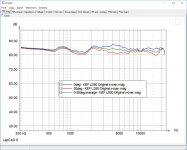 KEF LS50 - Original -- Freq - SIM 0-30deg + average.jpg211.3 KB · Views: 185
KEF LS50 - Original -- Freq - SIM 0-30deg + average.jpg211.3 KB · Views: 185 -
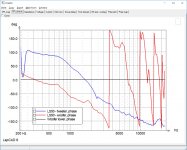 KEF LS50 - Original -- Phase - SIM 30deg.jpg230.2 KB · Views: 174
KEF LS50 - Original -- Phase - SIM 30deg.jpg230.2 KB · Views: 174 -
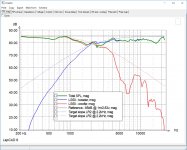 KEF LS50 - Original -- Freq - SIM 30deg RP.jpg248.6 KB · Views: 167
KEF LS50 - Original -- Freq - SIM 30deg RP.jpg248.6 KB · Views: 167 -
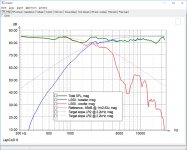 KEF LS50 - Original -- Freq - SIM 30deg.jpg248.7 KB · Views: 179
KEF LS50 - Original -- Freq - SIM 30deg.jpg248.7 KB · Views: 179 -
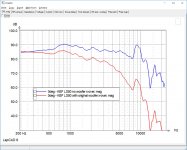 KEF LS50 - Original -- Freq - SIM 0deg woofer x-over.jpg212.1 KB · Views: 165
KEF LS50 - Original -- Freq - SIM 0deg woofer x-over.jpg212.1 KB · Views: 165 -
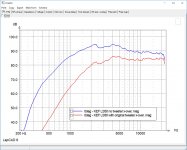 KEF LS50 - Original -- Freq - SIM 0deg tweeter x-over.jpg209.2 KB · Views: 175
KEF LS50 - Original -- Freq - SIM 0deg tweeter x-over.jpg209.2 KB · Views: 175 -
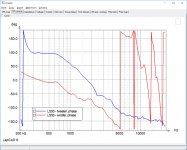 KEF LS50 - Original -- Phase - SIM 0deg.jpg224.3 KB · Views: 229
KEF LS50 - Original -- Phase - SIM 0deg.jpg224.3 KB · Views: 229 -
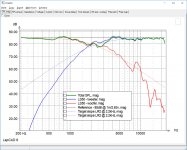 KEF LS50 - Original -- Freq - SIM 0deg RP.jpg243.6 KB · Views: 290
KEF LS50 - Original -- Freq - SIM 0deg RP.jpg243.6 KB · Views: 290 -
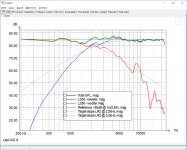 KEF LS50 - Original -- Freq - SIM 0deg.jpg241.9 KB · Views: 268
KEF LS50 - Original -- Freq - SIM 0deg.jpg241.9 KB · Views: 268
Last edited:
KEF LS50 was designed to carry on the tradition of LS3/5a the legendary British compact 2-way monitor designed in BBC for mobile radio broadcast units. The aim for LS3 was to monitor speech, and it has intentionally low bass and excaggerated low treble, to bring more "clarity". Room response below, LS50 red, L3/5a blue, from KEF LS50 Anniversary Model loudspeaker Measurements | Stereophile.com
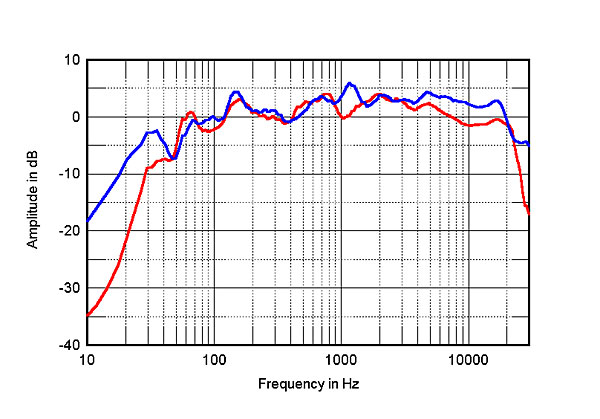

Somehow this speaker gained reputation and was followed by many variants/clones for domestic radio/stereo listening. A cult and specific identifialble sound signature.
"Signature sound
Typical of sealed-box speakers of similar size, the 3/5A has little or no low bass, but the design reinforced its lower register by a boost at around 160 Hz, giving the subjective impression that the speaker is more bass-rich.[7][10][15] It has a gently rising frequency response above 5kHz,[14] leading reviewers to notice the sound being a little bright at the treble registers, or that the speakers "reproduce the high-end roughness of solid-state amplifiers mercilessly" thus suggested partnering with valve amplification would be advantageous.[16][17][18] A slight nasal quality in the midrange has also been noted in the earlier versions.[3][10][18] The accuracy and stability of its stereo imaging and its clean midrange reproduction are also appreciated qualities.[10][17] "


Somehow this speaker gained reputation and was followed by many variants/clones for domestic radio/stereo listening. A cult and specific identifialble sound signature.
"Signature sound
Typical of sealed-box speakers of similar size, the 3/5A has little or no low bass, but the design reinforced its lower register by a boost at around 160 Hz, giving the subjective impression that the speaker is more bass-rich.[7][10][15] It has a gently rising frequency response above 5kHz,[14] leading reviewers to notice the sound being a little bright at the treble registers, or that the speakers "reproduce the high-end roughness of solid-state amplifiers mercilessly" thus suggested partnering with valve amplification would be advantageous.[16][17][18] A slight nasal quality in the midrange has also been noted in the earlier versions.[3][10][18] The accuracy and stability of its stereo imaging and its clean midrange reproduction are also appreciated qualities.[10][17] "
Last edited:
KEF LS50 was designed to carry on the tradition of LS3/5a the legendary British compact 2-way monitor designed in BBC for mobile radio broadcast units. The aim for LS3 was to monitor speech, and it has intentionally low bass and excaggerated low treble, to bring more "clarity". Room response below, LS50 red, L3/5a blue, from KEF LS50 Anniversary Model loudspeaker Measurements | Stereophile.com
Oh, yes I remember now! That's explains the voicing of the speaker!
In the next post I will present an alternative x-over suggestion for a more conventional loudspeaker voicing. I will not claim it will sound better than the original voicing of the speaker, but it will sound different and perhaps better suite those who's not liking the original speaker voicing.
Cheers,
/Göran
KEF LS50 AE v1-1 alternative x-over
Hi everyone,
Here's my simulation of an alternative KEF LS50 x-over called AE v1-1 and it’s based on measurements made by Zvu in post 1 in this thread.
Disclaimer! Not that I don’t trust the measurements done by Zvu, but since I haven’t done them myself and I only have the on-axis and the 30deg off-axis frequency measurements, I can’t guarantee 100% accuracy in these simulations.
However, they should be pretty close and can be a good starting point for further tweaking. Also, since I don’t have a pair of KEF LS50 in my possession and can’t confirm with listening tests that e.g. the balance between the woofer and the tweeter level is optimal. It’s a pure simulation, not verified by listening tests.
The AE v1-1 x-over design goals:
The AE v1-1 x-over design options:
In the next post I will post some comparison between the original and the AE v1-1 x-over.
Cheers,
/Göran
Picture1: KEF LS50 - AE v1-1 x-over schematics
Picture2: KEF LS50 - On-axis frequency response (AE v1-1 x-over)
Picture3: KEF LS50 - On-axis frequency response reverse tweeter polarity (AE v1-1 x-over)
Picture4: KEF LS50 - On-axis phase response (AE v1-1 x-over)
Picture5: KEF LS50 - On-axis tweeter frequency response (AE v1-1 x-over)
Picture6: KEF LS50 - On-axis woofer frequency response (AE v1-1 x-over)
Picture7: KEF LS50 - On-axis, the effect of C4 cap (AE v1-1 x-over)
Picture8: KEF LS50 - 0-30deg + 0-30deg average frequency response (AE v1-1 x-over)
Picture9: KEF LS50 - System impedance (AE v1-1 x-over)
Hi everyone,
Here's my simulation of an alternative KEF LS50 x-over called AE v1-1 and it’s based on measurements made by Zvu in post 1 in this thread.
Disclaimer! Not that I don’t trust the measurements done by Zvu, but since I haven’t done them myself and I only have the on-axis and the 30deg off-axis frequency measurements, I can’t guarantee 100% accuracy in these simulations.
However, they should be pretty close and can be a good starting point for further tweaking. Also, since I don’t have a pair of KEF LS50 in my possession and can’t confirm with listening tests that e.g. the balance between the woofer and the tweeter level is optimal. It’s a pure simulation, not verified by listening tests.
The AE v1-1 x-over design goals:
- Since I haven’t seen any distortion measurements of these driver units and any more detailed off-axis frequency measurements, I’ve kept the original x-over’s cross-over frequency of 2.2kHz.
- I’ve chosen a LR4 cross-over topology (acoustically).
- The x-over should use standard cap and resistor values in order to minimize the amount of components.
- I will not use an excessive amount of response shaping circuits for notching out every little frequency wrinkle, in order to keep down the x-over complexity.
- Improved phase response of the speaker compared to the original x-over.
The AE v1-1 x-over design options:
- The impedance correction circuit C5+L4+R2 is optional and not needed unless using tube amps. The impedance correction gives a system impedance of 4 ohms +/- 0.5 ohms between 200-22000Hz.
- The C4 cap is used for reducing the cone break-up at ~8.8kHz a bit further, but is optional.
- If the tweeter sounds too hot, a resistor (R0) can be used before the C1 cap. A good starting value is between 0.22-1.0 ohms.
- The C1, C2 and C4 should be of good quality e.g. Mundorf Mcap Audiophile MKP. Resistors are MOX resistors and the coils are of air-core type.
- The C2 cap consists of 2x15uF caps.
In the next post I will post some comparison between the original and the AE v1-1 x-over.
Cheers,
/Göran
Picture1: KEF LS50 - AE v1-1 x-over schematics
Picture2: KEF LS50 - On-axis frequency response (AE v1-1 x-over)
Picture3: KEF LS50 - On-axis frequency response reverse tweeter polarity (AE v1-1 x-over)
Picture4: KEF LS50 - On-axis phase response (AE v1-1 x-over)
Picture5: KEF LS50 - On-axis tweeter frequency response (AE v1-1 x-over)
Picture6: KEF LS50 - On-axis woofer frequency response (AE v1-1 x-over)
Picture7: KEF LS50 - On-axis, the effect of C4 cap (AE v1-1 x-over)
Picture8: KEF LS50 - 0-30deg + 0-30deg average frequency response (AE v1-1 x-over)
Picture9: KEF LS50 - System impedance (AE v1-1 x-over)
Attachments
-
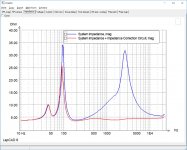 KEF LS50 - AE v1-1 -- IMP - SIM.jpg237 KB · Views: 231
KEF LS50 - AE v1-1 -- IMP - SIM.jpg237 KB · Views: 231 -
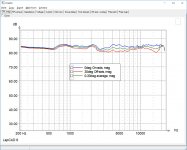 KEF LS50 - AE v1-1 -- Freq - SIM 0-30deg + average.jpg204 KB · Views: 227
KEF LS50 - AE v1-1 -- Freq - SIM 0-30deg + average.jpg204 KB · Views: 227 -
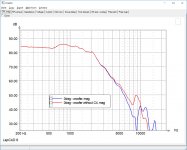 KEF LS50 - AE v1-1 -- Freq - SIM 0deg woofer.jpg198.4 KB · Views: 197
KEF LS50 - AE v1-1 -- Freq - SIM 0deg woofer.jpg198.4 KB · Views: 197 -
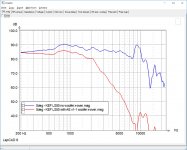 KEF LS50 - AE v1-1 -- Freq - SIM 0deg woofer x-over.jpg211.9 KB · Views: 190
KEF LS50 - AE v1-1 -- Freq - SIM 0deg woofer x-over.jpg211.9 KB · Views: 190 -
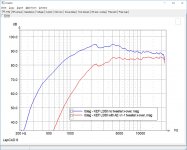 KEF LS50 - AE v1-1 -- Freq - SIM 0deg tweeter x-over.jpg208.3 KB · Views: 198
KEF LS50 - AE v1-1 -- Freq - SIM 0deg tweeter x-over.jpg208.3 KB · Views: 198 -
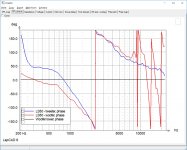 KEF LS50 - AE v1-1 -- Phase - SIM 0deg.jpg224.9 KB · Views: 221
KEF LS50 - AE v1-1 -- Phase - SIM 0deg.jpg224.9 KB · Views: 221 -
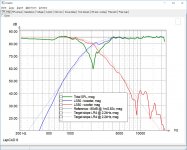 KEF LS50 - AE v1-1 -- Freq - SIM 0deg RP.jpg247.6 KB · Views: 286
KEF LS50 - AE v1-1 -- Freq - SIM 0deg RP.jpg247.6 KB · Views: 286 -
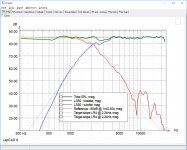 KEF LS50 - AE v1-1 -- Freq - SIM 0deg.jpg244.8 KB · Views: 370
KEF LS50 - AE v1-1 -- Freq - SIM 0deg.jpg244.8 KB · Views: 370 -
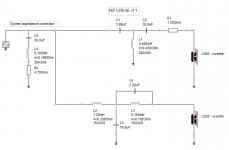 KEF LS50 - AE v1-1 x-over.jpg43.1 KB · Views: 404
KEF LS50 - AE v1-1 x-over.jpg43.1 KB · Views: 404
KEF LS50 AE v1-1 vs original x-over
Hi everyone,
Here's my simulation and comparison of the alternative KEF LS50 x-over called AE v1-1 and the original x-over. It’s based on measurements made by Zvu in post 1 in this thread.
As can be seen in the previous x-over simulations, the slightly hot tweeter between 2-6kHz is reduced and the depression between 0.9-2kHz of the original x-over is replaced by a depression between 2.4-3.8kHz in the AE v1-1 x-over.
This will change the tonal character of the speaker. How and how much must be determined by listening tests.
The different voicing and the better phase response of the alternative x-over design will probably give a more neutral character and a more coherent sounding speaker, but again, it must be determined and confirmed by listening tests.
Hopefully someone will test the AE v1-1 x-over and report back if it sounded good or not!
Cheers,
/Göran
Picture1: KEF LS50 - On-axis frequency response (AE v1-1 vs original x-over)
Picture2: KEF LS50 - 30deg off-axis frequency response (AE v1-1 vs original x-over)
Picture3: KEF LS50 - 0-30deg + 0-30deg average frequency response (AE v1-1 vs original x-over)
Hi everyone,
Here's my simulation and comparison of the alternative KEF LS50 x-over called AE v1-1 and the original x-over. It’s based on measurements made by Zvu in post 1 in this thread.
As can be seen in the previous x-over simulations, the slightly hot tweeter between 2-6kHz is reduced and the depression between 0.9-2kHz of the original x-over is replaced by a depression between 2.4-3.8kHz in the AE v1-1 x-over.
This will change the tonal character of the speaker. How and how much must be determined by listening tests.
The different voicing and the better phase response of the alternative x-over design will probably give a more neutral character and a more coherent sounding speaker, but again, it must be determined and confirmed by listening tests.
Hopefully someone will test the AE v1-1 x-over and report back if it sounded good or not!
Cheers,
/Göran
Picture1: KEF LS50 - On-axis frequency response (AE v1-1 vs original x-over)
Picture2: KEF LS50 - 30deg off-axis frequency response (AE v1-1 vs original x-over)
Picture3: KEF LS50 - 0-30deg + 0-30deg average frequency response (AE v1-1 vs original x-over)
Attachments
Great of you to join the party Goran,
I've uploaded your schematic and made it the resolution like in post no.5 in order to keep the uniformity of schematic vs frequency response grid. Hope you don't mind.
Cheers
View attachment 754230
No worries!
I'm more used to use 70-80dB scaling. Using a 40dB or lower scaling, might get you caught up in trying to fix every little wrinkle or suck out in the frequency response. After all, this is a simulation based on an anechoic measurement. The in room response will usually give you a lot more variation in the frequency response.
Nowadays I have stopped trying to fix very wrinkle in the response. Instead I let listening tests determine if a wrinkle is bad or not and if the level matching between the drivers are right or not.
Cheers,
/Göran
I couldn't agree more, final decision is derived by ears.
With me it's the other way around. I'm tired of listening and thinking if what i hear is bad music production or a peak/dip on frequency response. Nowadays i just make them very flat on and off axis and then i set the levels of drivers by listening.
So, basically it is the other side of the same coin
I'm not a factory to look at expenses for few coils and caps and don't really care if someone thinks my crossover is overly complicated for them - i do this for one reason and one reason only, to please myself I upload the files for others if they want to choose a different design path so they can do it their way and preference. I think it's fair since i've taken from community and got help when i needed it in past, about other things though but nevertheless. If someone likes what he hears when/if makes my crossover, good. If not, too bad. I always encourage people to simulate and DIY their own crossovers.
I upload the files for others if they want to choose a different design path so they can do it their way and preference. I think it's fair since i've taken from community and got help when i needed it in past, about other things though but nevertheless. If someone likes what he hears when/if makes my crossover, good. If not, too bad. I always encourage people to simulate and DIY their own crossovers.
And i'm very glad you've responded to this thread because i love different approaches. The more, the merrier
With me it's the other way around. I'm tired of listening and thinking if what i hear is bad music production or a peak/dip on frequency response. Nowadays i just make them very flat on and off axis and then i set the levels of drivers by listening.
So, basically it is the other side of the same coin
I'm not a factory to look at expenses for few coils and caps and don't really care if someone thinks my crossover is overly complicated for them - i do this for one reason and one reason only, to please myself
And i'm very glad you've responded to this thread because i love different approaches. The more, the merrier
Last edited:
Yes, seems to correspond very well with the measurements done by Zvu and the x-over simulations.
I tried very hard to like the LS50 (especially since it eliminated the top-octave nulls pretty all non-KEF coaxs have) but the elevated 2-5kHz range was really grating, just a frustrating sheen that obscures detail and tone especially of brass instruments. Göran's voicing is much more accurate and also aligns with my preferences more.
One of the mistakes Kef did with LS50, in my opinion, is lack of some manual attenuation of tweeter. One switch on the back that can attenuate 0, -1dB and -2dB would make it much more enjoyable product for different users.
I haven't had a feeling that LS50 tweeter is harsh even with factory crossover and especially now with my modified crossover. I have listened my unmodified LS50's extensively - toed in about 15 degrees to cross 0.5m in front of my listening position that is about 2.5m away from speakers.
I haven't had a feeling that LS50 tweeter is harsh even with factory crossover and especially now with my modified crossover. I have listened my unmodified LS50's extensively - toed in about 15 degrees to cross 0.5m in front of my listening position that is about 2.5m away from speakers.
Last edited:
LPF
Well, I have KEF Q100. Before months ago and my last mod, I always used a low pass filter to attenuate high frequencies. As I was solving my serious problems with the electrical grid and I was optimizing my Windows for multimedia I went up the cutting frequency.

foobar2000 + iZotope RX 2 Hum Remover (VST plugin). Nordost QRT QV2. | Nauscopio Scipiorum
Now I do not need the iZotope VST plugin anymore!
One of the mistakes Kef did with LS50, in my opinion, is lack of some manual attenuation of tweeter. One switch on the back that can attenuate 0, -1dB and -2dB would make it much more enjoyable product for different users...
Well, I have KEF Q100. Before months ago and my last mod, I always used a low pass filter to attenuate high frequencies. As I was solving my serious problems with the electrical grid and I was optimizing my Windows for multimedia I went up the cutting frequency.
foobar2000 + iZotope RX 2 Hum Remover (VST plugin). Nordost QRT QV2. | Nauscopio Scipiorum
An externally hosted image should be here but it was not working when we last tested it.
An externally hosted image should be here but it was not working when we last tested it.
Now I do not need the iZotope VST plugin anymore!
Last edited:
- Status
- This old topic is closed. If you want to reopen this topic, contact a moderator using the "Report Post" button.
- Home
- Loudspeakers
- Multi-Way
- KEF LS50 playground - measurements of raw drivers in factory cabinets and simulations
